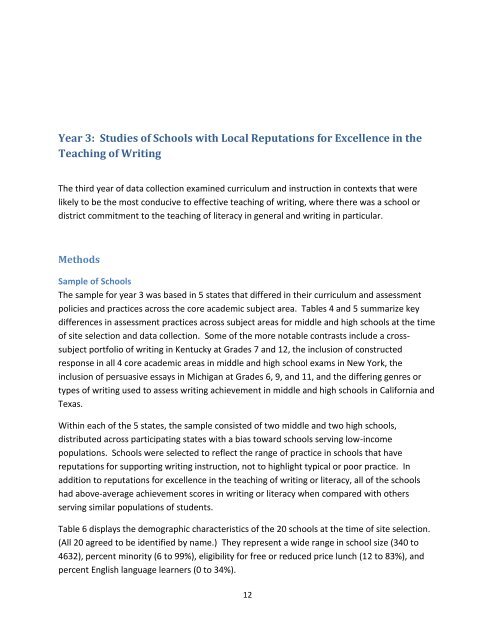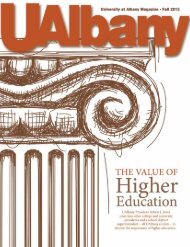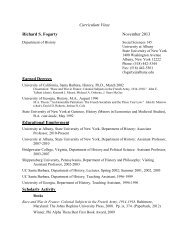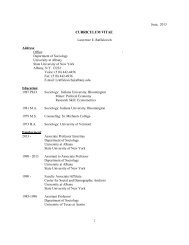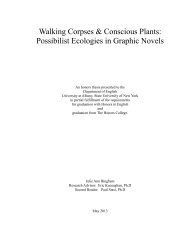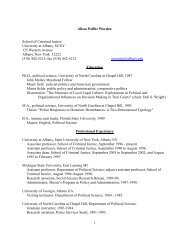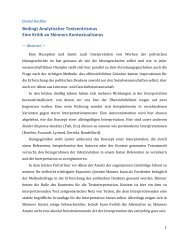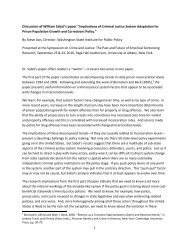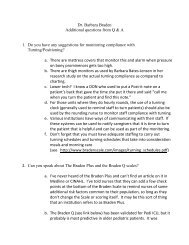The National Study of Writing Instruction - University at Albany
The National Study of Writing Instruction - University at Albany
The National Study of Writing Instruction - University at Albany
Create successful ePaper yourself
Turn your PDF publications into a flip-book with our unique Google optimized e-Paper software.
Year 3: Studies <strong>of</strong> Schools with Local Reput<strong>at</strong>ions for Excellence in the<br />
Teaching <strong>of</strong> <strong>Writing</strong><br />
<strong>The</strong> third year <strong>of</strong> d<strong>at</strong>a collection examined curriculum and instruction in contexts th<strong>at</strong> were<br />
likely to be the most conducive to effective teaching <strong>of</strong> writing, where there was a school or<br />
district commitment to the teaching <strong>of</strong> literacy in general and writing in particular.<br />
Methods<br />
Sample <strong>of</strong> Schools<br />
<strong>The</strong> sample for year 3 was based in 5 st<strong>at</strong>es th<strong>at</strong> differed in their curriculum and assessment<br />
policies and practices across the core academic subject area. Tables 4 and 5 summarize key<br />
differences in assessment practices across subject areas for middle and high schools <strong>at</strong> the time<br />
<strong>of</strong> site selection and d<strong>at</strong>a collection. Some <strong>of</strong> the more notable contrasts include a crosssubject<br />
portfolio <strong>of</strong> writing in Kentucky <strong>at</strong> Grades 7 and 12, the inclusion <strong>of</strong> constructed<br />
response in all 4 core academic areas in middle and high school exams in New York, the<br />
inclusion <strong>of</strong> persuasive essays in Michigan <strong>at</strong> Grades 6, 9, and 11, and the differing genres or<br />
types <strong>of</strong> writing used to assess writing achievement in middle and high schools in California and<br />
Texas.<br />
Within each <strong>of</strong> the 5 st<strong>at</strong>es, the sample consisted <strong>of</strong> two middle and two high schools,<br />
distributed across particip<strong>at</strong>ing st<strong>at</strong>es with a bias toward schools serving low-income<br />
popul<strong>at</strong>ions. Schools were selected to reflect the range <strong>of</strong> practice in schools th<strong>at</strong> have<br />
reput<strong>at</strong>ions for supporting writing instruction, not to highlight typical or poor practice. In<br />
addition to reput<strong>at</strong>ions for excellence in the teaching <strong>of</strong> writing or literacy, all <strong>of</strong> the schools<br />
had above-average achievement scores in writing or literacy when compared with others<br />
serving similar popul<strong>at</strong>ions <strong>of</strong> students.<br />
Table 6 displays the demographic characteristics <strong>of</strong> the 20 schools <strong>at</strong> the time <strong>of</strong> site selection.<br />
(All 20 agreed to be identified by name.) <strong>The</strong>y represent a wide range in school size (340 to<br />
4632), percent minority (6 to 99%), eligibility for free or reduced price lunch (12 to 83%), and<br />
percent English language learners (0 to 34%).<br />
12


